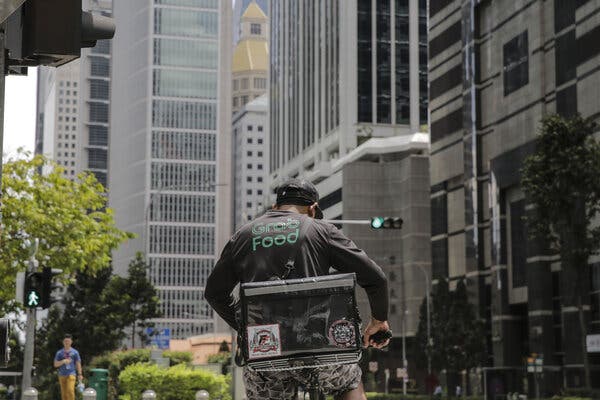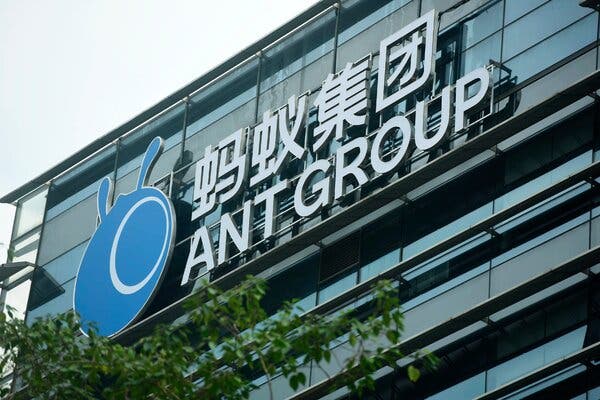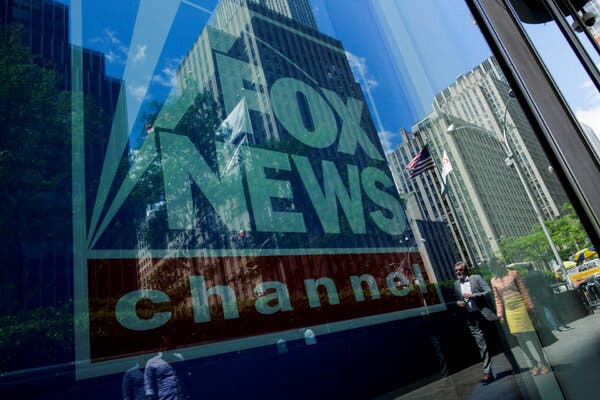When the government releases its latest consumer price inflation reading at 8:30 a.m. on Tuesday, Wall Street investors will be eagerly watching the data point, which is expected to jump starting this month.
Inflation data matters because it gives an up-to-date snapshot of how much it costs Americans to buy the goods and services they regularly consume. And because the Federal Reserve is charged in part with keeping increases in prices contained, the data can influence its decisions — and those affect financial markets.
But there’s a big reason not to read too much into the expected bounce in March and April — and it lies in so-called base effects.
In March’s data, inflation is expected to rise
substantially above 2 percent.
March 2021
forecast:
+2.5%
PERCENT CHANGE
IN CONSUMER
PRICE INDEX
FROM A YEAR AGO
However, some of the jump can be explained
through what’s known as base effects — prices fell
significantly last spring, so the increase now from the
year prior is larger, even if prices are not rising as
dramatically.
2021 Consumer price index

In March’s data, inflation is expected to rise substantially above 2 percent.
March 2021
forecast:
+2.5%
PERCENT CHANGE IN CONSUMER
PRICE INDEX FROM A YEAR AGO
However, some of the jump can be explained through what’s known as base effects —
prices fell significantly last spring, so the increase now from the year prior is larger, even
if prices are not rising as dramatically.
2021 Consumer price index
Consumer inflation is usually measured on a year-over-year basis. Statisticians take a bundle of goods and services Americans buy — everything from fresh fruit to apartment rent — and aggregate it into a price index. The inflation rate that is reported each month shows how much that index changed from one year to the next.
For a quarter century, most measures of inflation have held at low levels. The Consumer Price Index moves around a bit because of volatile food and fuel prices, but a “core” index that strips out those factors has mostly come in shy of 2 percent.
But the data reported for March and April may show something different because price indexes dropped sharply a year ago as the country went into lockdown and airlines slashed ticket costs, clothing stores discounted sweaters, and hotels saw occupancy plunge.
That means inflation measures are about to lap super-low readings, and as that low base falls out, it will cause the year-over-year percent changes to jump — a little bit in March, and then a lot in April.
To be sure, climbing prices could last for a while as businesses reopen, consumers spend down big pandemic savings and producers scramble to keep up with demand. Economists and Federal Reserve officials do not expect those increases to persist for more than a few months, but if they did, it would matter to consumers and investors alike.
But a bump in prices isn’t the kind of demand-driven inflation that would prompt the Fed to lift interest rates or slow bond buying in a bid to control prices. March’s figures are most likely just a mathematical quirk.

U.S. stock futures dropped on Tuesday after federal health agencies said there should be an immediate pause to the use of the Johnson & Johnson’s single-dose coronavirus vaccine.
The Food and Drug Administration and Centers for Disease Control and Prevention said on Tuesday that six women who received the vaccine had developed rare blood clots. “We are recommending a pause in the use of this vaccine out of an abundance of caution,” the agencies said.
The move could slow down the United State’s vaccination rollout, which could have ramifications for the global economic recovery. The S&P 500 is set to open 0.3 percent lower when markets start trading, futures indicated. Johnson & Johnson shares dropped 3 percent in premarket trading.
Treasury bond yields rose on Tuesday as traders prepared for a jump in the inflation rate when data is released later in the day. Economists surveyed by Bloomberg forecast the annual rate of inflation to rise sharply to 2.5 percent in March, from 1.7 percent the previous month. That would be the highest reading since January 2020.
But there’s a good reason not to read too much into the jump, The New York Times’s Ella Koeze and Jeanna Smialek write. That’s because prices plummeted this time a year ago. Inflation measures for March and April will lap these super-low readings, and as that low base falls out, it will cause the year-over-year percent changes to jump.
The yield on 10-year Treasury notes rose two basis points, or 0.02 percentage point, to 1.68 percent. When inflation increases, bond prices tend to fall and their yields rise because inflation eats away at the value of the payments investors get from bonds in the future.
Elsewhere in markets
-
The Stoxx Europe 600 reversed earlier gains and was little changed by early afternoon in Europe. The CAC 40 in France rose 0.2 percent and the DAX in Germany was little changed,
-
The biggest gainer in the FTSE 100 in Britain was JD Sports, a sports clothing retailer. Its shares rose 3.3 percent after the company’s earnings beat expectations in the 12 months through January, and dividend payments increased. On Monday, when stores in England reopened, there were long queues outside JD Sports stores in London.
-
Oil prices rose. Futures of West Texas Intermediate, the U.S. crude benchmark, gained 0.5 percent to just below $60 a barrel.

Grab — a ride-hailing company, bank and food delivery business all rolled into one — is set to make its debut in the largest offering by a Southeast Asian company on a U.S. stock exchange.
The company, which is based in Singapore, announced a deal on Tuesday with Altimeter Growth, a company listed for the sole purpose of buying a business. These special purpose acquisition vehicles, or SPACs, have snapped up companies over the past year at a rapid-fire pace. But this deal, which values Grab at roughly $39.6 billion, is expected to the largest such deal to date. Grab shares will trade on the Nasdaq stock exchange
The deal also includes an investment of more than $4 billion from a group that includes BlackRock, T. Rowe Price Associates and Temasek. Altimeter Capital Management, the investment firm backing the vehicle acquiring Grab, has agreed to hold certain shares in the company for at least three years.
Grab offers a “super app” that allows users to order food, pay bills and hail a car. It’s a model already popular in China, where WeChat offers a range of services, but is growing in Southeast Asia, particularly as the region builds its digital businesses. The pandemic helped propel the trend forward, with Southeast Asian consumers spending more than $10 billion online last year.
Grab acquired Uber’s Southeast Asia operations in 2018 and a digital banking license as part of a consortium in 2020. It has attracted investors including Booking Holdings, Hyundai, Microsoft, SoftBank and Toyota.
The company is going public as deal-making is flourishing in Southeast Asia. Bain, the consulting firm, said in 2018 it expected that the region would have had at least 10 unicorns, or start-ups valued at $1 billion or more, by 2024. One of those, the e-commerce company Sea, went public in the United States in 2017. Shares of the company have risen more than 400 percent over the past year, giving it a market capitalization of $125 billion.
“It gives us immense pride to represent Southeast Asia in the global public markets,” Grab’s chief executive, Anthony Tan, said in a statement. “This is a milestone in our journey to open up access for everyone to benefit from the digital economy.”

Credit Suisse said it would be able to pay back additional money to investors in funds whose troubles were among a series of disasters that have battered the Swiss bank’s reputation and finances.
The bank said it would pay an additional $1.7 billion to investors in funds linked to Greensill Capital, which collapsed last month. The latest payment means that investors will get back close to half of their money, with the prospect for more payments as Credit Suisse liquidates the funds.
Credit Suisse’s asset management unit oversaw $10 billion in funds put together by Greensill based on financing it provided to companies, many of which had low credit ratings or were not rated at all.
“There is potential for recovery in these cases although clearly there is a considerable degree of uncertainty as to the amounts that ultimately will be distributed to investors,” Credit Suisse said in a statement.
The more money that Credit Suisse can salvage from the funds, the better its chances of repairing its reputation and its ability to attract new customers. The bank has been in crisis following a series of debacles, including its disclosure last week that it will lose almost $5 billion because of money it lent to Archegos Capital Management, which crumbled this month after a high-risk stock market play went sour.
Including the $1.7 billion payment announced Tuesday, Credit Suisse has paid $4.8 billion to investors in the Greensill funds. The bank said it would take legal action to recover more money and “is engaging directly with potentially delinquent obligors and other creditors.” Some losses may be covered by insurance.
“We remain acutely aware of the uncertainty that the wind-down process creates for those of our clients who are invested in the funds,” Credit Suisse said. “We are doing everything that we can to provide them with clarity, to work through issues as they arise and, ultimately, to return cash to them.”

China has ordered 34 of its most prominent internet companies to ensure their compliance with antimonopoly rules within the next month and to submit to official inspections thereafter — with “severe punishment” promised for any illegal practices that are uncovered.
The demand, which China’s market regulator announced on Tuesday, represents the government’s latest cracking of the whip in its campaign to tighten supervision over giant internet platforms.
For years, Beijing gave internet companies wide berth to grow rich and innovate. But in China, as in the West, concerns have been growing about the ways the companies use their clout to edge out rivals, their use and abuse of algorithms and big data and their acquisitions of smaller peers. In recent months, China has begun using both regulatory enforcement actions and public shaming to keep tech companies in check.
The country’s market regulator imposed a record $2.8 billion antitrust fine on Alibaba, the e-commerce titan, on Saturday. And on Monday, Alibaba’s fintech sister company, Ant Group, unveiled a revamp of its business in response to government demands.
Officials from China’s market watchdog, internet regulator and tax authority met with the companies on Tuesday, according to the government’s statement. At the meeting, the officials “affirmed the positive role of the platform economy” but also told the companies to “give full play to the cautionary example of the Alibaba case.”
The nearly three dozen companies included almost all of the top names in the Chinese internet industry, from established titans like Alibaba, Tencent and Baidu to newer powerhouses such as TikTok’s parent, ByteDance; the food delivery giant Meituan; the e-commerce site Pinduoduo; and the video platform Kuaishou.
At Tuesday’s meeting, the companies were told to strengthen their “sense of responsibility” and to “put the nation’s interests first,” the regulator’s statement said.
The stock market’s rally during the pandemic has been nothing short of amazing. But rising interest rates are raising the question of how long this bull market can last.
In the 12 months through March, the average general stock mutual fund tracked by Morningstar returned nearly 66 percent — a remarkable rebound after a three-month loss of nearly 22 percent at the start of last year.
The turnaround came after the Federal Reserve stepped in with support for financial markets and the economy, fueling much of the stock market’s exuberance with low interest rates.
But with the economy taking off, rates have begun to rise. At the start of a new quarter, it is a good moment to ask, how long can these strangely prosperous times last?
My crystal ball is no clearer now than it has ever been, alas, and I can’t time the market’s movements any better than anyone else. But this certainly is a good time to assess whether you are well positioned for a possible downward shift.
As always, the best approach for long-term investors is to set up a portfolio with a reasonable, diversified asset allocation of stocks and bonds and then live with it, come what may.
Our quarterly report on investing is intended to help. If you haven’t been an investor before, we’ve included tips on how to get started. Here you will find broad coverage of recent trends, guidance for the future and reflections on personal finance in a challenging era.
An Uneasy Exuberance in the Stock Market
It’s been a long, fine run for the stock market, but a great deal of the upswing has depended on low interest rates, and in the bond market rates have been rising. Investment strategists are taking a wide array of approaches to deal with this difficult problem. For now, the bull market rides on.
Finding Safety Through Global Diversity
Bonds provide ballast in diversified portfolios, damping the swings of the stock market and sometimes providing solid returns. Because bond yields have been rising — and yields and prices move in opposite directions — bond returns have been suffering lately. But adding a diversified selection of international bonds to domestic holdings can reduce the risk in the bond side of your investments.
It’s Not Really All That Complicated
Yes, the markets and the economy are complicated. That often puts people off, and stops them from taking action that can help them and their families immeasurably: investing. But investing need not be complicated. A succinct article gives pointers on how to get started, and on how to navigate the markets for the long haul.
NFTs Are Great, but the Real Money Is in Dollars
After a piece of virtual art known as a nonfungible token — an NFT — sold at auction for $70 million recently, NFTs have suddenly became an asset that you can invest in. Our columnist prefers real dollars.
Fossil Fuel Prices Recovered, but for How Long?
Short-term demand for oil and gas is rising, but if climate change is to be reversed, consumption of fossil fuels will have to diminish. This leaves investors in a tough spot.

ArcLight Cinemas, a beloved chain of movie theaters based in Los Angeles, including the Cinerama Dome in Hollywood, will permanently close all its locations, Pacific Theaters announced on Monday, after the pandemic decimated the cinema business.
ArcLight’s locations in and around Hollywood have played host to many a movie premiere, in addition to being favorite spots for moviegoers seeking out blockbusters and prestige titles. They are operated by Pacific Theaters, which also manages a handful of theaters under the Pacific name, and are owned by Decurion.
“After shutting our doors more than a year ago, today we must share the difficult and sad news that Pacific will not be reopening its ArcLight Cinemas and Pacific Theaters locations,” the company said in a statement.
“This was not the outcome anyone wanted,” it added, “but despite a huge effort that exhausted all potential options, the company does not have a viable way forward.”
Between the Pacific and ArcLight brands, the company owned 16 theaters and more than 300 screens.
The movie theater business has been hit particularly hard by the pandemic. But in recent weeks, the majority of the country’s largest theater chains, including AMC and Regal Cinemas, have reopened in anticipation of the slate of Hollywood films that have been put back on the calendar, many after repeated delays because of pandemic restrictions. A touch of optimism is even in the air as a result of the Warner Bros. movie “Godzilla vs. Kong,” which has generated some $70 million in box office receipts since opening over Easter weekend.
Still, the industry’s trade organization, the National Association of Theater Owners, has long warned that the punishing closures were most likely to affect smaller regional players like ArcLight and Pacific. In March, the Alamo Drafthouse Cinema chain, which operates about 40 locations across the country, announced that it had filed for Chapter 11 bankruptcy protection but would keep most of its locations operational while it restructured.
That does not seem to be the case for Pacific Theaters, which, according to two people with knowledge of the matter, fired its entire staff on Monday.
The reaction to ArcLight’s closing around Hollywood has been emotional, including an outpouring on Twitter.
Devastating. Too many losses to process. It’s just too much… At some point when I’m less upset, I’ll tell you guys a funny story about my first time meeting Quentin Tarantino in the lobby of Hollywood Arclight. https://t.co/cFypJxEk4L
— Lulu Wang (@thumbelulu) April 13, 2021

The election technology company Smartmatic pushed back on Monday against Fox News’s argument that it had covered the aftermath of the 2020 presidential election responsibly, stating that Fox anchors had played along as guests pushed election-related conspiracy theories.
“The First Amendment does not provide the Fox defendants a get-out-of-jail-free card,” Smartmatic’s lawyer, J. Erik Connolly, wrote in a brief filed in New York State Supreme Court. “The Fox defendants do not get a do-over with their reporting now that they have been sued.”
The brief came in response to motions filed by Fox Corporation and three current and former Fox hosts — Maria Bartiromo, Jeanine Pirro and Lou Dobbs — to dismiss a Smartmatic lawsuit accusing them of defamation.
Smartmatic and another company, Dominion Voting Systems, became the focus of baseless conspiracy theories after the Nov. 4 election that they had manipulated vote totals in contested states. Those conspiracy theories were pushed by Rudolph W. Giuliani and Sidney Powell, serving as personal lawyers to former President Donald J. Trump, on Fox News, Mr. Trump’s longtime network of choice. Smartmatic, which says that the conspiracy theories destroyed its reputation and its business, provided election technology in only one county during the election.
Last month, Dominion also sued Fox News. Together, the two suits represent a billion-dollar challenge to the Fox empire, which, after Smartmatic filed its lawsuit, canceled the Fox Business program hosted by Mr. Dobbs.
“The filing only confirms our view that the suit is meritless and Fox News covered the election in the highest tradition of the First Amendment,” the network said in a statement late Monday.
Fox’s motion, as well as those of its anchors, argued that the mentions of Smartmatic were part of its reporting on a newsworthy event that it was duty-bound to cover: A president’s refusal to concede an election and his insistence that his opponent’s victory was not legitimate.
But the response Smartmatic filed on Monday, which runs for 120 pages, said that argument amounted to wishful thinking and that Fox had not covered the claims about Smartmatic objectively or fairly.
“The Fox defendants wedded themselves to Giuliani and Powell during their programs,” the brief said. “They cannot distance themselves now.”
Fox will have several weeks to respond to the brief, and a judge will eventually consider whether to allow Smartmatic’s case to proceed.

Reporters from multiple local organizations were denied entry to a news conference on Monday about the shooting of Daunte Wright, whose death at the hands of a police officer in Minnesota has set off protests.
Mr. Wright, 20-year-old Black man, was killed by the officer on Sunday during a traffic stop in Brooklyn Center, Minn., a suburb of Minneapolis. As national and international media flooded in, Brooklyn Center officials organized a news conference for Monday to address the shooting and release body-camera video.
Andy Mannix, a federal courts reporter for The Star Tribune, the largest newspaper in Minnesota, said on Twitter that he and his colleagues were denied access to the news conference while he watched national and international media be let in.
Suki Dardarian, a senior managing editor of The Star Tribune, said in an email that the paper had sent three journalists to the news conference. Two were denied entry, while one, a videojournalist, was able to get in, she said.
A spokeswoman for Minnesota Public Radio said that credentialed M.P.R. journalists also were not granted access. An article in The Star Tribune said journalists from the Minnesota Reformer, a nonprofit newsroom, were also denied.
Ms. Dardarian said local media should be allowed to attend police news conferences and ask questions.
“We were offered no explanation for why the reporter and photographer were not allowed in (as well as some other local journalists), except for someone saying the room was full,” Ms. Dardarian said. “Our videojournalist observed that there was still space in the room.”
“The chief indicated in his remarks that he is committed to transparency,” she said. “We believe that should include allowing the local media to attend a press conference to which they were invited — and agreeing to answer our questions following his statement.”
Dan Shelley, the executive director of Radio Television Digital News Association, a national industry group, said local journalists should be included in news conferences because they are part of the communities on which they’re reporting.
“If you have a genuine desire to be transparent, why would you exclude local journalists from a news conference?” Mr. Shelley said.
The city of Brooklyn Center and the city’s police department did not respond to requests for comment.






